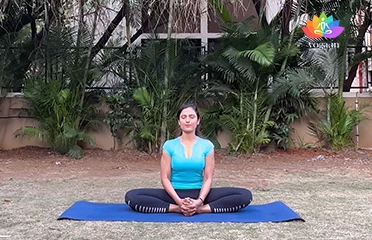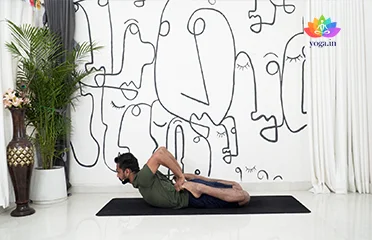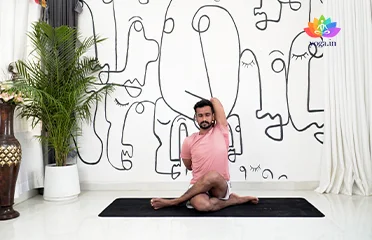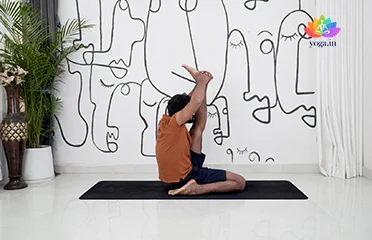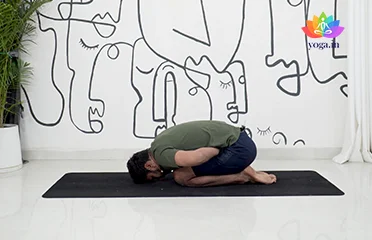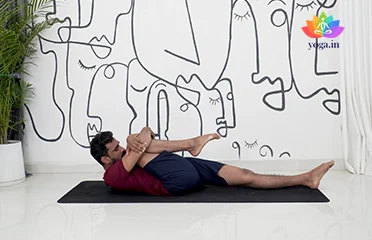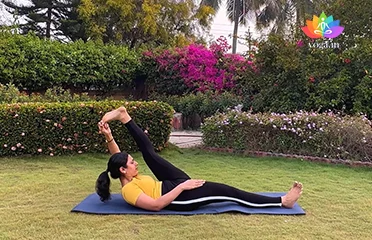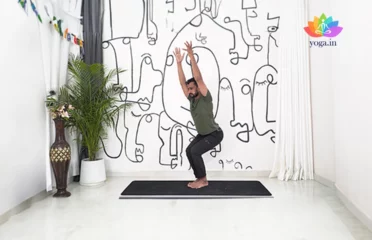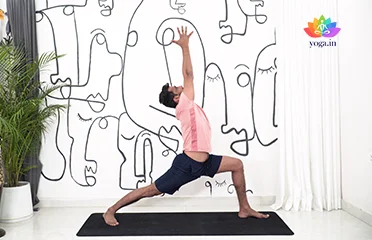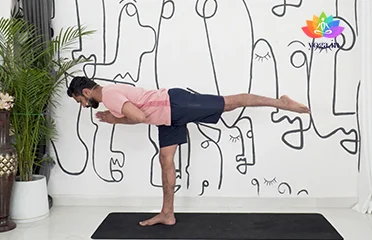Bhadrasana (Gracious Pose | Butterfly Po
भद्रासन / Gracious Pose | Butterfly Pose
The Sanskrit name is derived from Bhadra (भद्रा) meaning gracious, [�K]
Bhekasana (Frog Pose II)
भेकासन / Frog Pose II
The Sanskrit name is derived from Bheka (भेका) meaning frog and asana [�K]
Gomukhasana (Cow Face Pose)
गोमुखासन / Cow Face Pose
The Sanskrit name is derived from Gau (गो) meaning cow, Mukh meaning face [�K]
Kraunchasana (Heron Pose)
क्रौञ्चासन / Heron Pose
The Sanskrit name is derived from Kraunch (क्रौञ्च) meaning heron [�K]
Mandukasana (Frog Pose)
मण्डुकासन / Frog Pose
The Sanskrit name is derived from Manduka (मण्डुका) meaning frog [�K]
Pawanmuktasana (Wind Release Pose)
पवनमुक्तासन / Wind Release Pose
The Sanskrit name is derived from Pawan (पवन) meaning wind or gas, Mukta [�K]
Supta Padangusthasana (Reclining Posture
सुप्त पदंगुष्टासन / Reclining Posture
The Sanskrit name is derived from Supta (सुप्त) meaning 'supine or [�K]
Utkatasana (Chair Pose)
उत्कटासन / Chair Pose
The Sanskrit name is derived from Utkata (उत्कटा) meaning “powerful” [�K]
Virabhadrasana II (Warrior Pose 2)
विरभद्रासन II / Warrior Pose 2
The Sanskrit name is derived from Vira (विरा) meaning hero, Bhadra (भद्रा [�K]
Virabhadrasana III (Warrior Pose 3)
विरभद्रासन III / Warrior Pose 3
The Sanskrit name is derived from Vira (विरा) meaning hero, Bhadra (भद्रा [�K]
- 1
- 2
How Yoga Can Help Cure Flat Foot:
Flat foot, also known as pes planus, is a condition where the arches of the feet collapse, causing the entire sole to come into contact with the ground. It can lead to discomfort, pain, and difficulty in walking or standing for long periods. Yoga offers a holistic approach to addressing flat foot by strengthening the muscles, improving flexibility, and enhancing overall foot health. Let’s explore how yoga can be a valuable tool in managing and alleviating flat foot symptoms.
Understanding Flat Foot:
Flat foot is a common condition where the arches of the feet are flattened, causing the entire sole to touch the ground. This can occur due to various reasons, including genetics, injury, or muscle weakness. Flat foot can lead to instability, discomfort, and an increased risk of foot-related problems such as plantar fasciitis and Achilles tendonitis.
Yoga’s Role in Relieving Flat Foot:
Yoga offers a range of practices that can help alleviate the symptoms of flat foot and improve foot strength and flexibility. Specific yoga poses and techniques can target the muscles and ligaments of the feet, ankles, and lower legs, promoting better alignment and support. Additionally, yoga can help reduce inflammation, alleviate pain, and improve overall foot function.
Key Factors Contributing to Flat Foot:
Several factors can contribute to the development of flat foot, including:
- Genetics: Some individuals may inherit flat foot from their parents or family members.
- Muscle Weakness: Weakness in the muscles of the feet and lower legs can contribute to flat foot.
- Injury: Trauma or injury to the feet or ankles can lead to the development of flat foot.
- Obesity: Excess body weight can put added pressure on the feet, leading to flat foot.
- Aging: As we age, the ligaments and tendons in the feet may weaken, increasing the risk of flat foot.
Symptoms of Flat Foot:
Common symptoms associated with flat foot include:
- Pain or discomfort in the feet, especially after standing or walking for extended periods.
- Swelling or tenderness along the inner side of the foot.
- Difficulty in finding comfortable footwear due to changes in foot shape.
- Fatigue or cramping in the feet and lower legs.
- Reduced arch height or visible flattening of the arches.
Treatment of Flat Foot through Yoga and Pranayama:
Yoga and pranayama offer effective ways to manage flat foot and promote foot health. Some beneficial practices include:
Specific Yoga Poses:
- Tadasana (Mountain Pose): Improves posture and strengthens the feet and ankles.
- Vrikshasana (Tree Pose): Enhances balance and stability while stretching the feet and ankles.
- Virasana (Hero Pose): Stretches the feet and ankles while improving circulation.
- Gomukhasana (Cow Face Pose): Releases tension in the feet, ankles, and calves.
Pranayama Exercises:
- Dirga Pranayama (Three-Part Breath): Promotes relaxation and reduces stress, which can alleviate foot discomfort.
- Sitali Pranayama (Cooling Breath): Calms the mind and cools the body, providing relief from inflammation and pain.
Diet for Flat Foot:
In addition to yoga practices, maintaining a healthy diet can support foot health and overall well-being. Consider including foods rich in essential nutrients such as:
- Calcium: Found in dairy products, leafy greens, and fortified foods, calcium supports bone health and muscle function.
- Vitamin D: Sunlight exposure, fortified foods, and supplements can help maintain vitamin D levels, essential for bone health.
- Magnesium: Nuts, seeds, whole grains, and leafy greens are good sources of magnesium, which supports muscle relaxation and nerve function.
- Omega-3 Fatty Acids: Incorporate sources such as fatty fish, flaxseeds, and chia seeds to reduce inflammation and support joint health.
Caution for Flat Foot:
While practicing yoga for flat foot, it’s essential to:
- Listen to your body and avoid pushing beyond your limits, especially if you experience pain or discomfort.
- Choose supportive footwear with proper arch support and cushioning to reduce strain on the feet.
- Gradually increase the intensity and duration of yoga practices to avoid overloading the feet and lower legs.
Contraindications for Flat Foot:
Individuals with severe flat foot or related foot conditions should:
- Avoid high-impact activities or yoga poses that exacerbate discomfort or instability.
- Modify poses as needed to accommodate foot pain or limitations.
- Consult with a healthcare professional or qualified yoga instructor for personalized guidance and recommendations.


